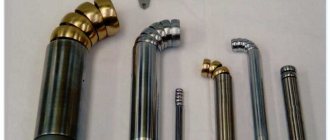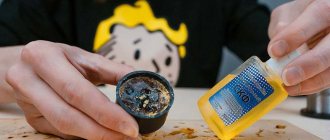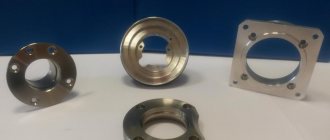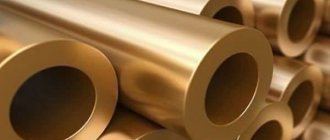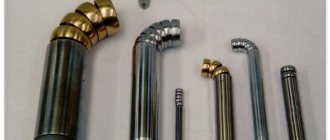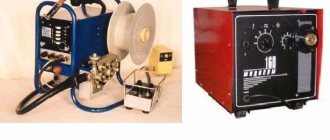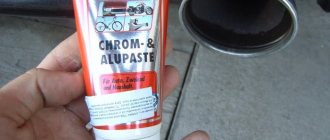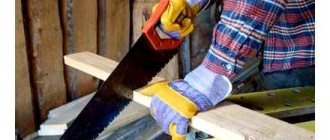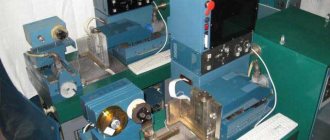Mechanical wear of parts
Mechanical wear of car parts occurs under the influence of friction forces. Which causes chipping, crumpling and destruction of the surface of the part.
Reducing mechanical wear can be achieved by selecting the material (steel - babbitt, steel - bronze, steel - cast iron). And increasing the frequency of processing of mating parts.
Automotive parts operating under difficult conditions (crankshafts, cylinders, etc.) are processed by grinding and polishing. The main cause of wear is friction. Depending on the nature of the movement of the mating parts, a distinction is made between sliding friction (friction of a shaft in a bushing, a piston in a cylinder, etc.) and rolling friction (in ball and roller bearings). With rolling friction, wear is tens of times less than with sliding friction.
The maximum wear of car parts is observed during dry friction. In all cases, one should strive to work under fluid friction conditions. This is achieved by following lubrication rules, using recommended types of oils and operating modes of interfaces.
Waterjet
The effect is similar to the previous one, but the role of the abrasive carrier is performed not by a gaseous medium, but by a liquid flow.
The following are susceptible to this effect:
- hydrotransport systems;
- hydroelectric power station turbine units;
- components of washing equipment;
- mining equipment used for washing ore.
Sometimes waterjet processes are aggravated by exposure to an aggressive liquid environment.
Cavitation
Pressure drops in the liquid flow flowing around the structure lead to the appearance of gas bubbles in the zone of relative rarefaction and their subsequent explosive collapse with the formation of a shock wave. This shock wave is the main active factor in the cavitation destruction of surfaces. Such destruction occurs on the propellers of large and small ships, in hydraulic turbines and technological equipment. The situation can be complicated by exposure to an aggressive liquid medium and the presence of an abrasive suspension in it.
Abrasive wear of parts
Abrasive wear is a type of mechanical wear. With this type of wear, the destruction of rubbing surfaces is caused by foreign particles. These are sand, dust and wear products that have increased hardness.
Parts of the chassis of cars and machinery are most susceptible to abrasive wear. Reducing abrasive wear can be achieved by installing filters, seals, and protective covers. And also by keeping the car clean, modern cleaning of parts of the connecting rod and piston group and the gas distribution mechanism from carbon deposits. Well, and intensive lubrication of rubbing parts.
Wear of metals due to friction
Friction is the main cause of wear of machine parts. The problems of friction, wear and lubrication are studied by the science of tribology, which is based on the fundamental laws of physics, chemistry, continuum mechanics, thermodynamics and materials science.
The tribological properties of metallic materials largely depend on the state of their surface layers. The destruction of most mechanical engineering products begins from the surface subjected to contact mechanical loads, corrosion and high temperatures. The greatest losses are associated with the development of wear processes on the surface of machine parts and tools. With the development of technology and the transition from macroscale to micro- and nanoscale levels of consideration of the structure and properties of materials, the role of the surface increases many times over.
The operation of any mechanism and machine is associated with the transfer of energy and the loss of part of the transmitted energy through friction. Friction process
accompanied by various influences, causes wear of the surface of materials. We can say this: everything that experiences friction wears out, and this statement is true in the general case, despite the impressive successes of tribology in creating wear-free friction units - exceptions only confirm the rule. Not everything that is worn out can be restored.
Wear (wear) in general can be characterized as a change in the size, shape, mass or state of the surface layer of a solid under the influence of the external environment. Wear can be caused by friction of the surfaces of machine parts against each other, exposure of the surface of the working environment to flows of liquid, gas, or contact of the surface with solid particles.
There are permissible and maximum wear. With acceptable wear, the functionality of the part remains, despite changes in its size and shape due to wear. Extreme wear is characterized by such changes in the size and (or) shape of a part in which further wear leads to loss of performance of this part and the friction unit or mechanism as a whole. It is clear that the permissible wear is less than the limit.
Types of wear include wear on a separate section of the friction surface, or local wear.
Chemical wear
Chemical wear (corrosive) occurs due to the action of acids, alkalis and other substances on parts. Which get into the mechanisms along with oil, fuel and from the air.
Chemical wear causes corrosion of the surface of parts. Which corresponds to the formation of rust on them. Corrosion causes enormous losses of metal. And it causes enormous damage to cars. Reducing the chemical wear of parts of the connecting rod and piston group and the gas distribution mechanism is ensured by the use of purified oils and fuels. As well as maintaining normal thermal conditions of the engine. Parts are protected from corrosion by various types of paint and electrolytic coatings. As well as timely lubrication.
Thermal
The thermal type of aging consists of the destruction of the surface layer of a material or a change in the properties of its deep layers under the influence of constant or periodic heating of structural elements to the plasticity temperature. Damage is expressed in crushing, melting and changing the shape of the part. Characteristic for highly loaded components of heavy equipment, rolls of rolling mills, hot stamping machines. It can also occur in other mechanisms when the design conditions for lubrication or cooling are violated.
Fatigue wear
Fatigue wear occurs when a part is exposed to loads that vary in magnitude and direction. Fatigue wear is characterized by cracks, peeling and peeling of metal from the surface of the part.
The following are susceptible to fatigue wear:
- crankshafts,
- swivel pins,
- springs,
- gears,
- raceways, rolling bearings and other parts.
Reducing fatigue wear is achieved by carefully treating the surfaces of parts. And also compliance with the established radii of curvature. And by eliminating scratches and nicks, which are centers for the initiation of fatigue cracks. To increase fatigue strength, some parts (springs, steering axles of cars, etc.) are subjected to shot blasting, embossing or roll rolling.
Periods of wear of equipment parts
The wear of most parts in the operation of each equipment interface can be divided into three periods. You need to know the causes and types of wear of parts. However, you still need to understand during what period what can be expected and how to prevent equipment breakdown.
In the initial period, wear increases quickly. During this period, the mating is worn in.
The second period characterizes the normal operation of the interface during operation of the machine. This is a period of natural wear and tear, the intensity of which depends on operating conditions, compliance with all maintenance rules and wear resistance of parts.
The third period begins after the mating gap reaches its limit value. During this period, if the interface operation is not stopped, emergency wear will begin.
Emergency wear also occurs in case of violation of technical conditions for repair and assembly of interfaces. The wear limits of parts vary widely. Thus, in the parts of fuel equipment, wear limits are expressed in microns, and in parts of the chassis of cars - in millimeters.
These are the main causes and types of wear of equipment parts that are found everywhere.
Adhesive
With prolonged friction, accompanied by plastic deformations of the participants in the rubbing pair, periodic convergence of surface areas occurs at a distance that allows the forces of interatomic interaction to manifest themselves. The interpenetration of atoms of substance of one part into the crystalline structures of another begins. Repeated occurrence of adhesive bonds and their interruption lead to the separation of surface zones from the part. Loaded rubbing pairs are subject to adhesive aging: bearings, shafts, axles, sliding bearings.
What is mechanical damage?
A special group of component defects consists of mechanical damage, which occurs in most cases as a result of gross violations of operating rules. Such defects include: dents, holes, cracks. Exposure to increased loads leads to bending and twisting of parts, failure of threaded, keyed and splined connections.
The main causes of these malfunctions are negligence in the repair and operation of machines and accidents. Thus, sudden cooling of an overheated block or freezing of water in its jacket can cause cracks to appear in these parts.
7.2. Types of destruction and fractures
Kink
– destruction of a part caused by low quality material, manufacturing defects, violation of operating rules, accidental mechanical damage and other factors. []
The type of fracture allows you to determine the reasons for its occurrence (Table 7.3).
Table 7.3 – Main types of fractures
| Appearance | Nature of development | Cause of occurrence |
| Ductile fracture | ||
| It has a fibrous structure, without a crystalline sheen (uneven areas scatter light - the fracture surface appears matte). A characteristic feature is the presence of lateral bevels along the edge of the fracture. | Accompanied by intense plastic deformation of the part material. Primary fractures are rarely ductile. A relatively slowly developing ductile crack is either detected in advance, or due to excessive plastic deformation, the part ceases to perform its functions even before failure. | Exposure to significant short-term forces that occur when a mechanism jams or a technological regime is disrupted. It can occur during prolonged action of forces that cause stresses exceeding the yield strength of the part material. |
| Brittle Fracture | ||
| It has a pronounced crystalline structure in non-deformable materials and shear-smooth in soft materials. The edges of the fractures are smooth, even, without bevels or with slight bevels. The bevel on a brittle fracture indicates the place where the fracture ends (end of fracture). | In most cases, they begin to develop in zones of stress concentration (at places where stiffeners are welded, at the intersection of welds, at holes and fillets, in zones of sharp changes in thickness). The origins are often welding defects (hot and cold cracks, lack of penetration, undercuts, slag inclusions, pores, metal delaminations). | Occurs suddenly with a single application of force or under the influence of repeated impact forces with a low degree of local plastic deformation. |
| Fatigue failure | ||
| Clearly identified: a zone of fatigue failure, which has a fine-grained structure, with a porcelain-like or polished surface; zone of static destruction - with a fibrous structure for ductile metals and coarse-grained for brittle ones. | They arise in the process of gradual accumulation of damage in the material of parts under the influence of alternating stresses, which lead to the formation of microcracks, their development and the final destruction of the part. | It is one of the main types of damage caused by cyclic loads. |
Rules for cleaning and inspecting a fracture [1]:
- do not remove loose fragments from the fracture surface;
- do not try to put together parts of the destroyed part;
- do not wipe the fracture with rags and brushes;
- The fracture is cleaned by blowing with compressed air followed by immersion in kerosene.
Features of hardening defects
are given in table 7.4. []
Table 7.4 – Hardening defects
| Manifestation | Cause |
| The hardened layer is fine-grained and uniform. | The temperature regime is maintained. |
| The fracture surface is fibrous, the file leaves a noticeable mark on the part. | The product was not heated to the required temperature. |
| The fracture surface is uneven in grain size. | The product was heated to a higher temperature than required. |
| The fracture is coarse-grained, with a strong white sheen. | The product was heated to an excessively high temperature and remained at this temperature for an extended period of time. |
| The fracture is heterogeneous, in places there are unhardened and well-hardened grains, burnt grains are observed on the ribs and thin parts. | The product was heated too quickly and unevenly. |
How to increase the durability of parts?
The durability of equipment parts can be increased by a system of repair and maintenance measures. Operational measures that increase the service life of parts include: compliance with the break-in regime during the initial period of vehicle operation, timely and high-quality maintenance work, avoidance of overloads and overheating, compliance with the rules for starting cars in cold weather.
Repair measures aimed at increasing the service life of machines include: obtaining high-quality surfaces by processing, maintaining the correct geometric shape of parts, and using advanced methods for restoring parts.
We can help with the repair and maintenance of your construction, road, municipal and agricultural equipment in Moscow and the Moscow region. We carry out all types of repairs. To do this, call the phone number on this page or fill out the order form and we will call you back. And we will eliminate all causes and types of wear of parts of your equipment.

